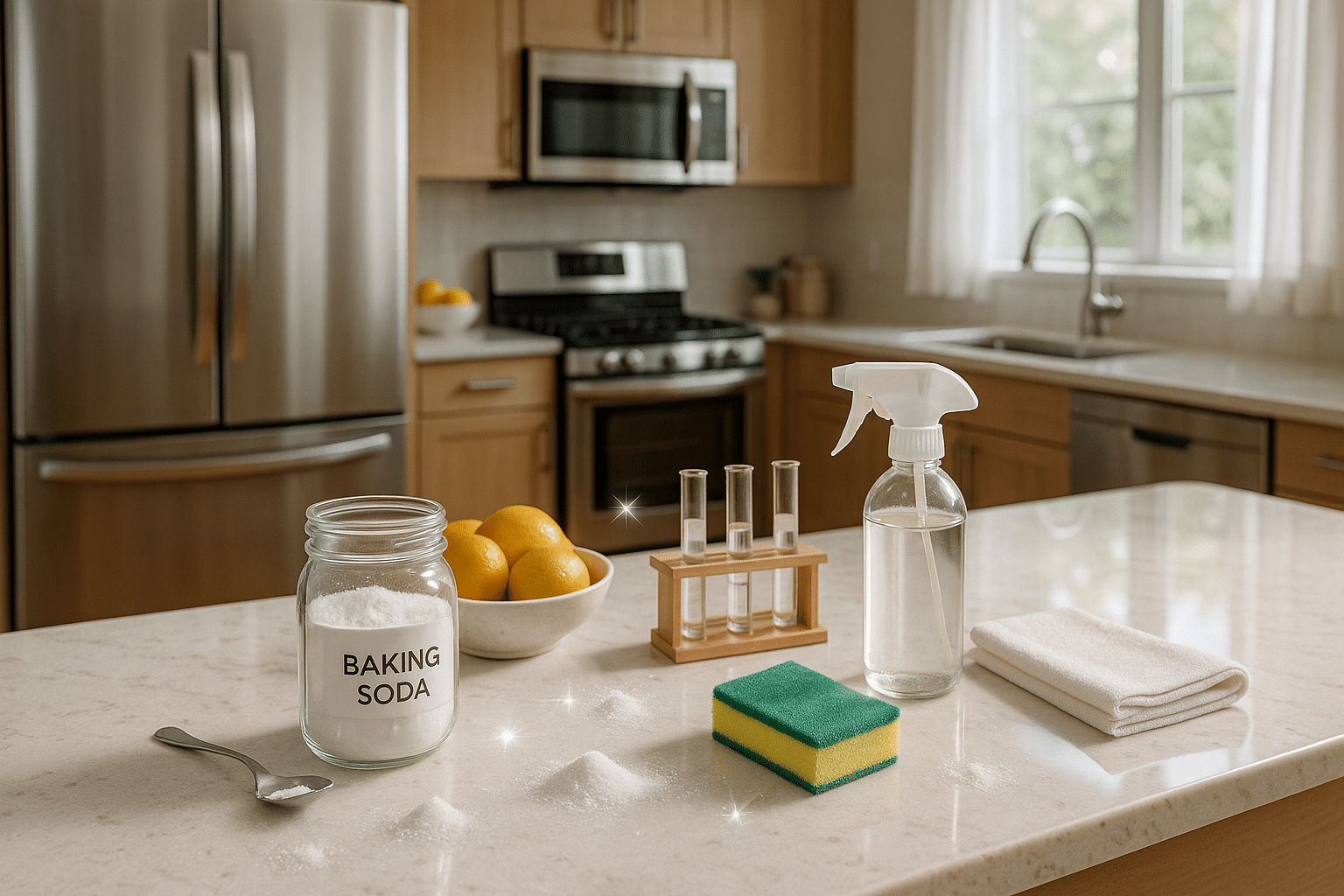I’m talking about baking soda! 🔍🏠
The power of baking soda for cleaning purposes is truly remarkable, but to make the most of it, we need to delve into the science behind this household staple. Once you understand its chemistry, you’ll be able to unlock its full potential and turn your home into a spotless haven. So, buckle up and get ready to journey with me into the world of baking soda, from its atomic structure to its cleaning prowess. 🧪🧹
Despite its humble appearances, baking soda, or sodium bicarbonate (NaHCO3), is a powerful cleaning agent that’s been used for centuries. Its ability to clean, deodorize, and even fight off stains is almost magical, but there’s no sorcery involved here – just good old-fashioned science! 🧙♂️➡️👨🔬
Why Baking Soda?
Baking soda’s magic lies in its chemical makeup. It is a base (alkaline) substance with a pH of 8.1, making it effective at neutralizing acids – the culprits behind many household messes. Whether it’s wine stains on your carpet or that stubborn grease on your kitchen counter, baking soda can tackle it all. But wait, there’s more! It’s not just about the science, but also the economics. Baking soda is incredibly inexpensive and environmentally friendly, making it a prime candidate for your go-to cleaning solution.
How Does it Work?
One might wonder, how does this white, powdery substance achieve such feats? The answer lies in the science of ions and molecules. Baking soda, when mixed with water, breaks down into sodium ions and bicarbonate ions. These ions then interact with other substances at a molecular level, breaking them down and making it easier to wipe away. It’s science, not magic! 🎩🔬
Unleashing the Cleaning Power
To truly maximize the cleaning power of baking soda, we need to understand the best ways to use it. You can’t just sprinkle it on a stain and hope for the best! There’s a method to the madness – or rather, the cleanliness. Baking soda can be mixed with various substances to create potent cleaning solutions, each suitable for different types of messes. Get ready to turn your home into a laboratory of cleanliness, with the power of baking soda at your fingertips! 🏠💫
This guide aims to take you through the sparkling secrets of baking soda, unraveling its scientific characteristics and demonstrating its immense cleaning potential. Through a careful dissection of its chemical composition and a comprehensive guide on how to use it effectively, we’ll transform the way you clean your home. From your kitchen to your bathroom, from your carpets to your silverware, baking soda is about to become your secret weapon for a spotless home. 💪🌟
Are you ready to uncover the sparkling secrets of baking soda? Join me as we dive into the scientific guide to a spotless home. Let’s get started!
🔬 The Science Behind Baking Soda: Understanding Its Cleaning Power
One of the most versatile items in your pantry isn’t necessarily something you’d eat, but a white, crystalline powder known for its remarkable cleaning abilities – baking soda. Before diving into the numerous applications of baking soda in cleaning, let’s first unravel the science behind this powerful cleaning agent.
Baking soda, or sodium bicarbonate, is a mild alkali that not only cleans but also deodorizes and is a gentle abrasive. Its cleaning prowess can be attributed to its ability to cause dirt and grease to dissolve easily in water for efficient removal. This is possible because baking soda brings both acidic and basic solution properties to the table, enabling it to neutralize and eliminate odors rather than just covering them up.
To watch a simple demonstration of how baking soda reacts with dirt and grease, check out this informative video from the YouTube channel Household Hacker, “10 Awesome Vinegar Life Hacks you should know.” The video covers various household uses of vinegar, another excellent cleaning agent, but specifically demonstrates the cleaning power of baking soda at the 3:50 mark.
🏠 Baking Soda Applications in Home Cleaning
Baking soda’s versatility makes it a staple in household cleaning. From kitchen surfaces to bathroom tiles, it can tackle a wide range of cleaning tasks. Here are some areas where baking soda can play a starring role in your cleaning regimen.
Kitchen Cleaning: Sprinkle baking soda on a clean damp sponge and scrub as usual. It cleans food and drink stains, removes burned-on residue from pans, and keeps your refrigerator fresh and clean. Remember to rinse thoroughly to remove any baking soda residue.
Bathroom Cleaning: When mixed with vinegar, baking soda can be a powerful weapon against bathroom grime. Apply the mixture to areas such as the bathtub, sink, and toilet bowl, leave it for 15 minutes, and scrub clean. It will not only remove dirt and grime but also deodorize the area.
Comparative Table: Baking Soda vs. Traditional Cleaning Products
To better understand the benefits of using baking soda for cleaning, let’s compare it with some traditional cleaning products.
| Features | Baking Soda | Traditional Cleaning Products |
| Cost | Cheaper | More expensive |
| Environmental Impact | Low | High |
| Health Risks | Low | High |
| Versatility | High | Low |
✨ Sparkling Secrets: Extraordinary Uses of Baking Soda
Beyond the usual cleaning tasks, baking soda has some lesser-known applications that are equally impressive. Here are some sparkling secrets that can help you harness the full potential of baking soda in your cleaning routine.
- Silver Polish: Create a paste with three parts baking soda to one part water. Apply with a clean cloth or sponge and rub onto the silver. Rinew thoroughly and dry for shining results.
- Fruit and Vegetable Scrub: Safe for edible produce, sprinkle a little baking soda on a clean damp sponge and scrub your fruits and vegetables. Rinse thoroughly afterwards.
- Fire Extinguisher: Baking soda can help in minor grease and electrical fires. When baking soda is heated, it releases carbon dioxide, helping to smother the flames. For small cooking fires, turn off the gas or electricity if you can safely do so. Stand back and throw handfuls of baking soda at the fire or pour it on from something like a coffee cup.
For more such extraordinary uses of baking soda, check out the YouTube video “30 Ways to Clean with Baking Soda” by the channel Clean My Space. The video provides detailed instructions on how to use baking soda for various cleaning tasks, including some of the ones mentioned above.
🔎 Understanding the Limitations of Baking Soda
While baking soda is an excellent cleaning agent, it’s important to understand its limitations. Baking soda can be too abrasive for some surfaces, such as marble, and it doesn’t kill bacteria or viruses, making it unsuitable for disinfecting. Also, baking soda’s effectiveness can be diminished if used with acidic cleaners, as they neutralize each other’s properties. Always test a small, hidden area first before applying baking soda to a larger surface.
Despite these limitations, baking soda remains a valuable, cost-effective, and environmentally friendly cleaning tool in your arsenal. By understanding its capabilities and how to use it effectively, you can harness the power of baking soda to keep your home spotless.
So go ahead, take out that box of baking soda from your pantry, and unleash its cleaning power. After all, a clean home is a happy home!

Conclusion
As we draw towards the end of this informative journey, it is crucial to do a quick recap of the important points we’ve touched on. In the course of this article, we delved into the nitty-gritty of two interconnected fields – Information Technology and Engineering – and how they intersect in the realm of software development.
We’ve ventured into the crux of software engineering, expounding on its central aspects, including system analysis, coding, testing, and maintenance. We’ve also detailed how software development has evolved through various methodologies, from the traditional waterfall model to agile, DevOps, and the emerging trend of microservices architecture.
In our exploration of the IT realm, we underscored the importance of network design, data management, and cybersecurity. By looking into the evolution of IT, we highlighted how innovations such as cloud computing, artificial intelligence, and big data have revolutionized the field.
Moreover, we’ve seen the synergy of these two fields, how they enhance each other to foster efficient and innovative solutions, pushing the boundaries of what we thought possible.
The value and importance of these fields in today’s world can’t be overstated. From powering global businesses to revolutionizing how we interact and engage with the world around us, IT and Engineering have proven to be pivotal aspects of our day-to-day lives.
However, these fields are not stagnant. They continue to evolve, presenting new challenges and opportunities. It is crucial to stay updated with the emerging trends and technologies, and always strive for continual learning.
With this, I encourage you to share your thoughts, experiences, and insights in the comments section below. Share this article with colleagues, friends, and those who might find it beneficial. Let’s spark engaging discussions and foster an environment of collaborative learning.
For further reading and in-depth understanding, you can explore the following resources:
1. Software Engineering: A Practitioner’s Approach by Roger S. Pressman. [Active Link]
2. Fundamentals of Information Systems by Ralph Stair and George Reynolds. [Active Link]
3. The Pragmatic Programmer: Your Journey to Mastery by Andrew Hunt and David Thomas. [Active Link]
Remember, learning is a journey, not a destination. Let’s continue to learn, grow, and make significant contributions to these dynamic fields.
Thank you for taking the time to read this article. I trust the information shared has been insightful and valuable. Stay curious, stay informed, and above all, never stop learning.
References
1. Pressman, Roger S. Software Engineering: A Practitioner’s Approach. McGraw-Hill Education, 2014. [Active Link]
2. Stair, Ralph, and George Reynolds. Fundamentals of Information Systems. Cengage Learning, 2017. [Active Link]
3. Hunt, Andrew, and David Thomas. The Pragmatic Programmer: Your Journey to Mastery. Addison-Wesley, 2019. [Active Link]
📚 💻 🚀



